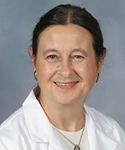“The pulmonary division is knee deep in the clinical management of hospitalized and ventilated patients, and our surgical colleagues in orthopedics have stopped elective procedures. So the ability of some specialties to remain engaged with these outpatient clinics is less than it used to be,” says Dr. Kolfenbach.
“Obviously, we are trying to be respectful of that, and as a result we’ve hit the pause button on some of these clinical rotations,” he notes. “In the rheumatology clinic, our volume has dropped some, as well. We’ve converted probably 90% of outpatient visits to telemedicine, reserving in-person visits for those who still require the traditional face-to-face encounter.”
Kristine M. Lohr, MD, MS, professor of medicine, rheumatology division chief and director of the rheumatology fellowship program at the University of Kentucky School of Medicine, Lexington, says the new social distancing rules mean she is the only one in the rheumatology office most of the time. Conferences initially held in large rooms to accommodate physical separation quickly shifted to video communication on Zoom.
“Our fellows stay home to study, except for the fellow on call for inpatient consults or weekends. We appreciate the ACR’s ViRL conferences and Dr. Jack Cush’s RheumNow [presentations],” Dr. Lohr says.
“What the fellows miss is the opportunity to do procedures, [because] patients aren’t coming in for visits,” she says. “The number of COVID-19 patients in our hospital has not reached the point [at which] providers and staff are being called into service.”
When it comes to adopting new technology, the younger you are, the smoother the sailing, say some program directors. Incorporating the technological aspects of telemedicine into the clinic presented a steep learning curve for Dr. Libman and a shining moment for her students.
“Our fellows are technology savvy, so they quickly figured out how to see patients, with the fellow seeing the patient first, presenting [patient information] to the attending, then creating a three-way call for the attending to review and confirm the plan [with the patient],” says Dr. Libman.
“The most surprising part of this [situation] was how easy and enjoyable it was to use telemedicine [after] we understood the technology—and the coding and billing requirements,” she says.
At the University of Colorado, fellows review patient charts the week before a scheduled visit to identify which patients are appropriate for a telemedicine visit. Virtual visits via Epic’s electronic medical records system allow the fellows to work from home. They receive an electronic notification that the patient and staff are online and ready for the appointment. In minutes, the patient chart and live pictures of each person show up on a screen the fellow operates from a computer or cell phone.




